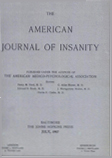EXPERIMENTAL "SHOCK THERAPIES" IN CATS WITH INSULIN AND METRAZOL
Abstract
The effect of sniffles on the central nervous system is difficult to evaluate. We are also at a loss to explain the peculiar changes of the pulmonary vessels. We were unable to find any references in the literature pertaining to this condition. Congestion and hemorrhages in thoracic and abdominal organs were equally pronounced in both treated and control animals.
It should be emphasized that in every animal brain one could see instances of ischemic homogeneous changes as well as acute pallor, swelling and chromatolysis, often side by side. Cells undergoing cyto-or karyolysis could always be found. Other neurocytes were entirely normal and showed well-stained Nissl substance.
In view of the findings of other workers, Ammon's horn was studied with particular care in every instance. We agree with Winkleman's and Moore's observations that there are no widespread changes in this area subsequent to either insulin or metrazol injections.
Access content
To read the fulltext, please use one of the options below to sign in or purchase access.- Personal login
- Institutional Login
- Sign in via OpenAthens
- Register for access
-
Please login/register if you wish to pair your device and check access availability.
Not a subscriber?
PsychiatryOnline subscription options offer access to the DSM-5 library, books, journals, CME, and patient resources. This all-in-one virtual library provides psychiatrists and mental health professionals with key resources for diagnosis, treatment, research, and professional development.
Need more help? PsychiatryOnline Customer Service may be reached by emailing [email protected] or by calling 800-368-5777 (in the U.S.) or 703-907-7322 (outside the U.S.).



